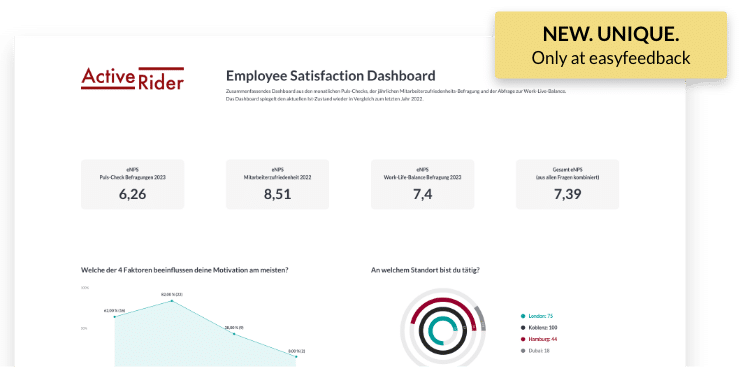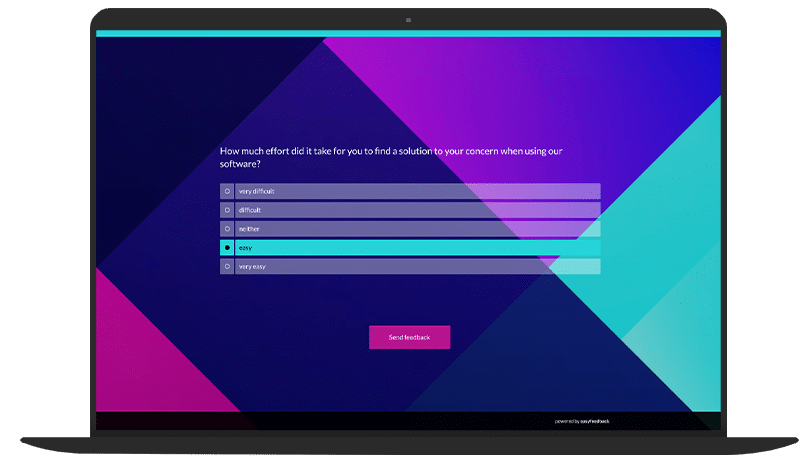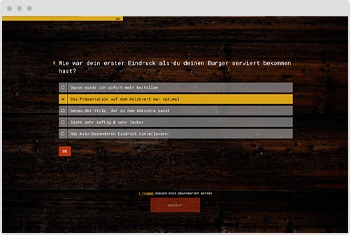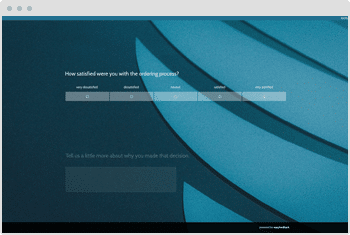Optimize the customer experience with the Customer Effort Score

Improve customer experience - strengthen customer loyalty - increase profitability. With easyfeedback and our ready-made CES template, you can immediately ask how effortful an interaction or the solution of a problem was from the customer's point of view.
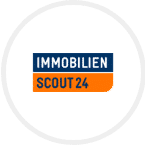
“Identifying customer needs is an essential part of our business. easyfeedback accompanies us for many years as a loyal partner in this task. We particularly appreciate the intuitive usability of the survey tool as well as the professional support.”
Guild Lead User Experience Research

“We use easyfeedback for internal and external surveys – fast, comfortable and really easy! Straightforward and cordial support can always create a smile. We really appreciate the permanent development of the platform.”
Guest & Competitor Insights Analyst
Content and targets of this CES template
Every company has the goal of having satisfied customers and retaining them in the long term.
However, this is not always easy to achieve. In order for companies to achieve this goal as well as possible, key performance indicators are needed that allow the satisfaction and loyalty of customers to be measured continuously so that suitable countermeasures can be initiated in the event of difficulties.
Metrics such as willingness to recommend, customer retention rate, or external industry benchmarks are among the ways to measure customer satisfaction and loyalty. But there are other metrics that make it possible to better understand customers.
According to a study by Dixon, Freeman & Roman , which looked at the importance of customer service to customer loyalty, 94% of respondents said they would remain loyal to a company by making a new purchase, for example, if they had a low effort in resolving their problems and concerns. In contrast, 81% of respondents would be more likely to terminate their relationship and speak negatively about the company if they had a high level of effort.
One suggestion on how to reduce the level of effort invested to solve a problem is the Customer Effort Score (CES), or Customer Effort Index, proposed by the authors of the study.
Similar to the NPS survey, the Customer Effort Index survey consists of only one question from which information about customer satisfaction can be derived.
You too can find out about the complexity of your customers’ interactions and problem solving to optimize their satisfaction and experience with your company and product. Take advantage of regular and simple CES surveys.
Content:
• Determine effort to solve problems
• Measure customer satisfaction & loyalty with metrics
• Identify customer wishes & needs
Targets:
• Prevent customer churn
• Strengthen customer loyalty
• Optimize customer experience
• Increase customer satisfaction

Data privacy protection „made in Germany“ (GDPR)

Anonymity functions for open feedback
Almost everything you need to know about the Customer Effort Score
1. What is the Customer Effort Score (CES)?
The CES is a metric that is collected using a specific type of question in a customer satisfaction survey. It tells you how uncomplicated an interaction with your company/product was from the customer’s point of view, for example how easy it was to find the right contact person or to get answers to their questions. Based on this, measures can be implemented to optimize and reduce complexity in order to enhance the user experience.
Additionally, the Customer Effort Score provides insight into customer loyalty, which contributes to customer satisfaction. In the rapidly growing competitive field of any industry, it is important to measure customer loyalty to minimize churn rates.
2. Why should you conduct a CES survey?
A CES survey gives you a good overview of how much effort a customer has to put in to solve a problem or concern with a product, for example. The survey uncovers potentials and helps you to specifically address areas that require optimization.
Because only if you know the areas in which your customers have difficulties do you have the opportunity to make improvements. The Customer Effort Score quickly shows which areas need to be optimized in order to increase customer satisfaction.
It is particularly important to carry out continuous surveys. Even in areas that have already been optimized, it is helpful to find out whether the adjustments you have made are having the desired effect or whether you need to make further adjustments.
3. For example, where can the Customer Effort Score be applied?
There are many ways to query the level of effort required to resolve your customer’s issue after an interaction with you or your product.
For example, you can apply a CES survey after each email or phone contact with your support to ask how trouble-free the interaction with support was.
Furthermore, you can measure your customers’ effort after each of your help articles. This will help you find out how quickly your customers were able to find the answer to their questions.
Another possible use case would be to survey how much effort customers had to put in to solve a problem with your product.
As you can see, the CES survey can be used for many scenarios. Especially when it comes to asking about the customer experience in terms of the effort required to fix a problem.
4. How is the Customer Effort Score calculated?
Calculating the CES is relatively simple and can be done in two ways.
Basically, CES survey participants indicate the effort required to interact with your product or company using a scale from 1 (extremely easy) to 7 (extremely difficult).
Now, to calculate your Customer Effort Score, you can either take the average of all scores:
CES = Summer of Scores / Number of Scores
You can do the calculation in the style of the Net Promotor Score.
This means that the participants’ answers are divided into three categories. The first category includes the participants who rated the interaction with a score of 1 or 2. These are the customers who had a low effort with the interaction. The second category is formed by the participants who gave a score of 3 or 4. These are the customers who had a medium effort. In the last category come all the participants who gave the score 5 to 7 in the CES survey and thus had a high effort with the interaction.
Now the Customer Effort Score is calculated according to the Net Promotor Score method as follows:
CES = Percentage of participants with a high effort score (%) – Percentage of participants with a low effort score (%).
The resulting value ranges from -100% to +100%. Where -100 % is the worst value and +100 % is the best value.
5. What is a good CES score?
Unfortunately, it is not possible to say exactly.
But generally speaking, the closer the score is to +100% according to the NPS calculation or to 1 when calculated according to the average scores, the more satisfied the customers were with the respective interaction.
If an interaction results in a score of less than 0 (in the NPS calculation) or at 7 (as an average score), then this is an indication that the interaction involves a lot of effort for the customer. This means that there is a need for action on the part of your company.
6. Are there any tips on how to use the Customer Effort Score?
Yes, there are. Below we have compiled four tips for the application of the Customer Effort Score for you:
Tip 1: Ask directly after the interaction
The sooner you ask the customer about the complexity of the interaction, the fresher their memory and the more valuable the feedback. If you wait too long, not only the quality of the feedback may suffer, but also the willingness to participate in the effort survey.
Tip 2: Use regularly
In order for the CES to help you determine customer satisfaction and effort after each interaction with your company or product, you must use the CES survey regularly and over time. Only then will you be able to tell if your customers had a positive or negative experience with the interaction options you offer, such as contacting your support or reading your help articles.
Tip 3: Don’t use a welcome page
Start your CES survey directly with the interaction effort question. A welcome page with text and information can already lead to abandonment, as the participant thinks it’s a longer survey. However, in the end, the participant only has to answer a single question.
Tip 4: Respond to feedback
If you have enough feedback on one of your offered interactions, then depending on whether the feedback is negative or positive, you should respond to it. Nothing is worse than letting the feedback go unused and not striving to improve.
You are in professional company







easyfeedback welcomes more than 740.000 participants per month!
